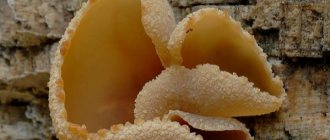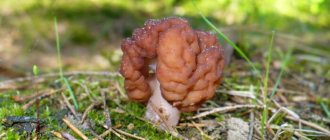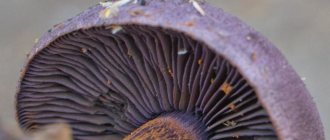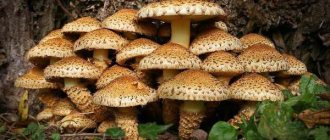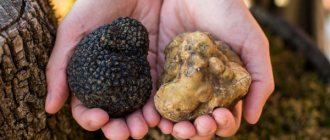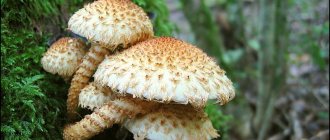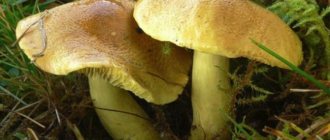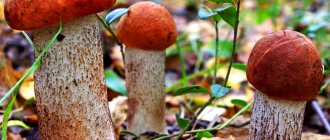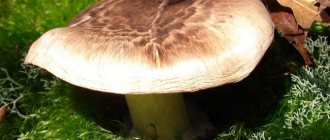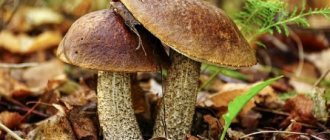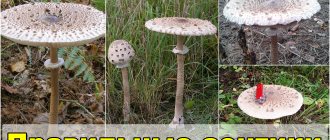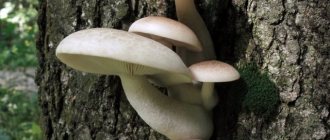Cherry (cherry, cherry, clitopilus) is an edible mushroom belonging to the Entolomaceae family. The culture received its name due to the peculiarity of its growth under rosaceous fruit trees: cherries, pears, plums, apple trees, apricots. A characteristic feature of this mushroom is its powdery odor, reminiscent of the aroma of a fresh cucumber.
Due to their high taste and nutritional properties, hanging fruits are very popular in cooking.
Distribution and collection
Like many mushrooms, the name of the pinnacle refers to where it can be found most often - namely, next to the root system of the Rosaceae. Cherry and apple trees are good landmarks for searching for honeydew. But it is also found near broad-leaved trees such as oak and beech, and sometimes it can be found in spruce forests, where there are no traces of fruit trees.
The fungus prefers acidic and acidic soils; it is practically not found on neutral and alkaline soils. The distribution area is almost the entire temperate zone of Europe.
The harvesting period for cherry blossoms is from mid-July to September. Grows singly or in small groups.
Doubles and their differences
The differences between all relatives of the cherry tree are slight, so they are very difficult to notice when picking mushrooms. Poisonous counterparts that pose a serious health hazard:
Bitter sulphur
The pulp is very bitter (as the name suggests), and there are concentric cracks on the cap. Poisonous and life threatening.
Waxy talker
The only difference: there are no zonal rings, which is especially noticeable at high humidity. Some sources point to the pink tint of the plates as a sign of a poisonous mushroom, but this sign is not always correct.
The differences are quite vague, which should serve as a warning to inexperienced mushroom pickers. Careful study of the photo and description of the cherry mushroom will help you avoid poisoning.
Use
The mushroom is edible after boiling for 15 minutes. Further, honeycomb can be used in all types of culinary processing, including canning in salted or pickled form. The taste of cherry blossom dishes is quite specific and has many supporters and opponents.
As you can see, the valuable properties of the mushroom are practically reduced to nothing by the fact that there is a very high risk of taking its poisonous double into the basket. So there is no need to take unnecessary risks.
Description of the pendant
The diameter of the cap is 4-10 centimeters. The shape of the cap is convex, but over time it opens up and sometimes becomes funnel-shaped. The color of the cap is quite variable; it can be whitish or yellow-gray. The surface of the cap is smooth, shiny, and can be dry or slightly moist. The cap is not zoned and not hygrophanic.
The flesh of the cap is elastic, thick, white in color. The pulp has a strong powdery odor and sometimes has a cucumber aroma. The plates descend along the stem, often located, the same color as the cap. When the spores mature, the plates become slightly pinkish. Pink spore powder.
The height of the leg is 3-6 centimeters, and the thickness is most often 1 centimeter, but sometimes reaches 1.5 centimeters. The leg is often curved and uneven. Its color is the same as the hat, or it can be a little lighter. The pulp in the stem is fibrous and white.
Spread of hanging flowers
Cherry blossoms grow everywhere in forests of various types. They can be found among grass and woodlands. These mushrooms prefer acidic soils. Cherry blossoms form mycorrhizae with Rosaceae, but sometimes they grow in spruce forests where there are no cherry or apple trees. Cherry blossoms bear fruit from July to September.
Edibility of cherry blossoms
These are edible mushrooms, according to some sources they are highly valuable. But hanging fruits have a strong floury smell, which not everyone likes.
In addition, these mushrooms are similar to poisonous talkers, so they should be collected with caution
Similar species
There are a huge number of species in the genus Clitopilus, and most of them are similar to the cherries; they can only be distinguished thanks to microscopic features.
Govorushki also have similarities with pendants; a distinctive characteristic of the pendants are the pinkish plates, but, unfortunately, they cannot always be seen.
The waxy rhizome differs from the poisonous talker by its cap without concentric circles. Also, cherry blossom is similar to the great white chanterelle, but it smells like cucumbers or flour.
Description
hat
The diameter reaches about 4-10 centimeters. It is smooth and dry to the touch; in humid weather it becomes a little sticky and shiny. The shape of the cap is round, regular, the edges are strongly tucked in the young mushroom, but not so pronounced in the old one, but still noticeable. The shape is first convex, then flat, often taking the shape of a funnel, similar to the chanterelle.
The cap is colored from white to white-yellow, but the color may vary depending on the growing conditions and the specific location of the mushroom.
There is no hygrophanic color change, and there are no zonal rings either.
The flesh of the cap is strong, elastic, fleshy, does not change color when broken or cut, but darkens when pressed. The taste of the pulp is mealy, unexpressed, the smell is similar to the aroma of a cucumber.
Spore-bearing layer
Lamellar, the plates are thin, quite frequent, and as the mushroom matures and ages, they can take on a pinkish tint.
There is still some confusion regarding the classification of this fungus, since even when examined under a microscope it is not always possible to distinguish it from related species. Therefore, the pink color of the plates cannot be considered a 100% defining feature; often no color change occurs at all.
Leg
Cylindrical, smooth from the base and slightly widening towards the cap, where the plates of the spore-bearing layer begin to descend onto the stem. It is tender to the touch, slightly velvety, often pubescent, especially in young specimens. The flesh is slightly denser than the cap, with the same mealy-cucumber aroma.
Treatment for poisoning
After hospitalization, the patient undergoes detoxification:
- enema;
- gastric lavage;
- hemodialysis.
The choice of treatment method depends on how much of the dangerous product the patient ate.
Later, the patient’s water-electrolyte (salt) balance is restored or a drip is placed. The victim must also adhere to a special diet:
- Avoid eating fatty, spicy and smoked foods;
- eat only boiled food;
- Finely chop vegetables and fruits before eating.
When providing first aid, you should not induce vomiting in children under 3 years of age and pregnant women. Also, enemas are not given to older people without the help of a doctor. The victim is prohibited from taking medications that strengthen the stomach
This is especially important when poisoning with dangerous mushrooms such as toadstool
Today, a large number of edible, as well as inedible and deadly ones are known, or which can safely be called doubles due to their pronounced external similarity. Almost all lovers of “silent hunting” with many years of experience are well versed in mushrooms and can quite easily distinguish edible species. An information table will help novice mushroom pickers distinguish between inedible and life- and health-threatening twin mushrooms.
Edible mushroom or not
Cherry mushrooms are used as food:
- fresh after boiling;
- for preparing second courses (stewing);
- as a filling for baked goods;
- for preparing sauces and aromatic seasonings;
- for drying, pickling and marinating.
Cherry is considered a delicacy in Europe. It is rich in phosphorus compounds (up to 45%), which are necessary for the human body.
The harvested crop is dried. Before use, mushrooms are soaked for an hour. Cherry has a pleasant taste and serves as a good addition to dishes.
Attention! When stewing, the pulp is only slightly boiled down, which is considered a valuable quality. Extracts of this mushroom are used in medicine as an anticoagulant.
Recommended for people with increased blood clotting and those who suffer from thrombosis
Extracts of this mushroom are used in medicine as an anticoagulant. Recommended for people with increased blood clotting and those who suffer from thrombosis.
Symptoms of poisoning
The first signs of poisoning may appear within 30-40 minutes after eating a mushroom dish, but more often this occurs several hours later.
Signs of waxy mushroom poisoning include:
- nausea, vomiting, diarrhea;
- pain in the abdomen;
- hypersalivation (salivation);
- increased sweating;
- constriction of the pupils, blurred vision;
- changes in heart function (bradycardia).
A particularly dangerous sign is shortness of breath caused by pulmonary edema. In severe cases, the patient falls into a coma. Poisoning with muscarine-containing mushrooms, including waxy mushrooms (leaf-loving mushrooms), can result in the death of young children, the elderly and people with problems of the cardiovascular and respiratory systems.
Regular consumption of small amounts of mushrooms with muscarine causes drug addiction.
Definitioner
Basidia (Basidia)
Lat. Basidia. A specialized structure of sexual reproduction in fungi, unique to basidiomycetes. Basidia are terminal (end) elements of hyphae of various shapes and sizes, on which spores develop exogenously (outside).
Basidia vary in structure and method of attachment to hyphae.
Based on the position relative to the axis of the hyphae to which they are attached, three types of basidia are distinguished:
Apical basidia are formed from the terminal cell of the hypha and are located parallel to its axis.
Pleurobasidia are formed from lateral processes and are located perpendicular to the axis of the hypha, which continues to grow and can form new processes with basidia.
Subbasidia are formed from a lateral process turned perpendicular to the hyphal axis, which stops growing after the formation of one basidium.
Based on morphology:
Holobasidia are single-celled basidia, not divided by septa (see Fig. A, D).
Phragmobasidia are divided by transverse or vertical septa, usually into four cells (see Fig. B, C).
By type of development:
The heterobasidium consists of two parts - the hypobasidium and the epibasidium developing from it, with septations (see Fig. C, B) or without them (see Fig. D).
Homobasidia is not divided into hypo- and epibasidia and in all cases is considered to be holobasidium (Fig. A).
The basidium is the site of karyogamy, meiosis, and the formation of basidiospores. Homobasidy, as a rule, is not functionally divided, and meiosis follows karyogamy. However, the basidia can be divided into probasidium, the site of karyogamy, and metabasidium, the site of meiosis. Probasidium is often a resting spore, for example in rust fungi. In such cases, the probasidium germinates into a metabasidium, in which meiosis occurs and on which basidiospores are formed (see Fig. E).
See Karyogamy, Meiosis, Hypha.
Pileipellis
Lat. Pileipellis, skin - a differentiated surface layer of the cap of agaricoid basidiomycetes. The structure of the skin in most cases differs from the inner flesh of the cap and may have a different structure. The structural features of pileipellis are often used as diagnostic characters in descriptions of fungal species.
Based on their structure, they are divided into four main types: cutis, trichoderma, hymeniderma and epithelium.
See Agaricoid fungi, Basidiomycete, Cutis, Trichoderma, Hymeniderma, Epithelium.
Kutis
The type of cap skin consists of creeping, ungelatinized hyphae located parallel to the surface. The surface of the cap looks smooth.
Lat. Cutis.
See Hypha.
Taxonomy[edit | edit code]
Species Clitocybe candicans
sometimes divided into several narrower species with blurred boundaries. Clitocybe gallinacea
sometimes used to refer to mushrooms with widely grown blades and a bitter taste.
Synonymsedit | edit code
- Agaricus candicans Pers., 1801 : Fr., basionym
- Agaricus gallinaceus Scop., 1772
- Agaricus umbilicaris JFGmel., 1792, nom. nov.
- Agaricus umbilicatus Bolton, 1788, nom. illeg.
- Clitocybe aberrans Velen., 1939
- Clitocybe alboumbilicata Murrill, 1915
- Clitocybe candens Murrill, 1916, nom. superfl.
- Clitocybe candicans (Pers.) P.Kumm., 1871
- Clitocybe gallinacea (Scop.) Gillet, 1874
- Clitocybe gossypina Velen., 1939
- Clitocybe tenuissima Romagn., 1954
- Omphalia candicans (Pers.) Gray, 1821
- Omphalia gallinacea (Scop.) Quél., 1886
Global file usage
This file is used in the following wikis:
- Uses of Clitopilus prunulus - Lindsey.jpg
Clitopilus prunulusat ast.wikipedia.org
- Uses of Clitopilus prunulus - Lindsey.jpg
Padvishanat be.wikipedia.org
- Uses of Clitopilus prunulus - Lindsey.jpg
Clitopilusat ceb.wikipedia.org
- Uses of Clitopilus prunulus - Lindsey.jpg
Cap melinyddat cy.wikipedia.org
- Uses of Clitopilus prunulus - Lindsey.jpg at en.wikipedia.org Entoloma sinuatum
- Clitopilus prunulus
- Clitopilus
Clitopilus
at es.wikipedia.org
Errotari
at eu.wikipedia.org
ალუბლიძირა
at ka.wikipedia.org
Clitopilus prunulus
at pms.wikipedia.org
- Entoloma sinuatum
pendant
at ru.wikipedia.org
Clitocybe rivulosa
at sr.wikipedia.org
Clitopilus
at sv.wikipedia.org
- Pidvyshen
Clitopilus
at vi.wikipedia.org
Clitopilus
at war.wikipedia.org
- Q856834
Honeydew (Clitopilus prunulus)
Other names for the mushroom: Charmwort
Synonyms:
- Ivyshen
- Vishniac
- Clitopilus vulgaris
Cap of the pendant: 4-10 cm in diameter, convex in youth, with age it opens to funnel-shaped, although not always. The color is quite variable, from white to yellowish-gray, and can vary significantly depending on growing conditions and the specific “strain”. The surface is smooth, dry or slightly moist, shiny (the latter variety is sometimes called Clitopilius prunulus var. orcellus), not hygrophanous and not zoned. The cap flesh is white, thick, elastic, with a strong mealy (or perhaps cucumber) odor.
Laminae: Partial, descending along the stem, cap-colored; with age, as the spores mature, they turn slightly pink (judging by the suffering with identifying the fungus, it is not always noticeable).
Spore Powder: Pink.
Leg: Height 3-6 cm, thickness about 1 cm (in rare cases up to 1.5 cm), uneven, often curved, solid. The color is like the cap or a little lighter, the flesh of the leg is white and fibrous.
Distribution: Various varieties of Honeydew are found from July to the end of September everywhere in forests of various types, in open forests, among grass, invariably preferring acidic soils. The fungus forms mycorrhiza, as a rule, with rose-flowered plants, but it can also be found in spruce forests without the slightest trace of apple and cherry trees.
Similar species: The genus Clitopilius contains a huge number of species, many of which are extremely similar to Clitopilius prunulus and differ only in microscopic characters. Another thing is that many white talkers can look like a wonderful hanging mushroom. Important distinctive features can be pinkish plates (alas, not always and not much), a non-hygrophanic cap without concentric circles (excellent protection against the poisonous waxy talker (Clitocybe cerussata)/leaf-loving (Clitocybe phyllophila))
In general, it is important to understand that cherry is a mushroom that is very similar to a large white chanterelle, but smells like flour or cucumbers
Edibility: The mushroom is edible and, according to some sources, is considered highly valuable, but the strong floury smell is not to everyone’s taste, and the similarity with poisonous talkers and nutritionally unknown entolomes forces one to moderate gastronomic ambitions.
Comments It’s easy to say now, but to be honest, we’ve had a lot of trouble with this. A mushroom that looked like a large white chanterelle came across me often and regularly, each time irritating and perplexing me. More for the sake of order than for common sense, I considered him a waxen talker, but one cannot deceive oneself endlessly. The main problem was that the appearance of the familiar mushroom was so “talking” that it never occurred to me to conscientiously pick an adult specimen and sow spores to see their color. As soon as this was done, the long-awaited clarification came; Yes, before us is a simple cherry tree, Clitopilius prunulus, or rather, one of the countless subspecies of this extremely fickle species of mushroom.
Podvishen mushroom
from questions in recognition:
LAT
Characteristics:
| Group: | Lamellar |
| Records: | Pinkish, white |
| Color: | From white to white-yellow |
| Info: | The pulp has a cucumber aroma |
Taxonomy:
| Department: | Basidiomycota (Basidiomycetes) |
| Sub-department: | Agaricomycotina (Agaricomycetes) |
| Class: | Agaricomycetes (Agaricomycetes) |
| Subclass: | Agaricomycetidae (Agaricomycetes) |
| Order: | Agaricales (Agaric or Lamellar) |
| Family: | Entolomataceae |
| Genus: | Clitopilus (Clitopilus) |
| View: | Clitopilus prunulus (Cherry blossom) |
At first glance, this mushroom resembles the familiar chanterelle, only white and with the smell of cucumber. Few people know this mushroom; even fewer collect it. Experienced mushroom pickers love this mushroom, considering it one of the most delicious, but not everyone risks taking it into their basket - this mushroom is little known and is unpleasantly similar to some poisonous species. Classified as 4 flavor category.
Chemical composition
The nutritional value of honey berries is determined primarily by their chemical composition. At the same time, the biological properties of mushrooms directly depend on the type of soil, climate, meteorological conditions, age of the plant, and growing method.
Main components:
- Water. Freshly picked cherries consist of 85-95% H2O (relative to the total weight of the fruiting body). However, during heat treatment, mushroom tissue loses about 45% of moisture, and when dried, up to 90%.
- Proteins. The anhydrous residue of cherries consists of 40-50% nitrogenous compounds (depending on the stage of development and growing conditions). Moreover, there are significantly more of them in the plant’s cap than in the stem (due to the presence of the hymenial layer bearing spores).
Protein structures account for 60-70% of the total amount of nitrogenous compounds (3-5% of the wet weight of the fungus). The remaining 30% includes intermediate metabolites of protein metabolism. Namely: amino acids (leucine, arginine, tyrosine, glutamine), fungin (mycetin), organic bases (adenine, xaitin, hypoxanthine), fiber (chitin, cellulose), gaseous substances (carbon, oxygen, hydrogen).
Despite its rich nitrogen composition, mushroom protein belongs to the group of difficult-to-digest compounds (due to the content of lignin, cellulose and chitin). In view of this, people with diseases of the digestive tract should limit their consumption of the product.
- Carbohydrates. Mushrooms are close to vegetables in terms of the quantitative and qualitative composition of saccharides. The concentration of carbohydrates in fruiting bodies varies from 2 to 7% (depending on growing conditions). A distinctive feature of mushrooms is the presence in their tissues of unsaturated aldehydes (trans-2-nonenals), which give the plant a specific cucumber aroma. In addition, the composition of mushroom tissue includes glycogens, saccharides (glucose, trihalose), fiber, sugar alcohols (mannitol, inositol, volemite, sorbitol). In humid weather, these substances accumulate on cherry caps, causing mucus on the outer surface of the fruiting body.
- Lipids. 0.1-0.9% fats are concentrated in the tissues of the hanging mushroom (relative to the total weight of the mushroom). Moreover, 80% of the compounds are concentrated in the plant cap (in the spore-bearing layer). The main representatives of “mushroom” lipids are free fatty acids (acetic, palmitic, butyric, stearic), provitamin D (ergosterol), lecithin (inositol, choline). In addition, the composition of cherry fruiting bodies includes fatty acid glycerides, essential oils, lipoids, and phosphatides.
- Minerals. Micro- and macroelements make up 6-11% of the solid residue of anhydrous weight (ash). Potassium accounts for 43% of the total mineral composition, phosphorus - 40%, sulfur - 7%, cobalt - 3%, magnesium - 2%, calcium - 1.3%, iron - 1%.
- Vitamins. In terms of nutritional content, cherry is equal to berries and fruits. Vitamins B1, , , , , D are concentrated in the fruiting body of the mushroom.
Cherry, due to its low energy value (38 kilocalories per 100 grams of mushroom mass), is included in dietary programs for weight loss. In addition, an extract from the plant is used in folk medicine as an anticoagulant, tonic, antianimic, and antithrombic agent.
Ivyshen (orchard)
Cherry (Clitopilus prunulus) is a cap mushroom from the group of lamellar mushrooms.
The cap is 3-10 cm, convex in a young mushroom, then becomes depressed or even funnel-shaped, with a wide tubercle in the middle, with an unevenly wavy edge, white, whitish or yellowish.
The plates extend down to the stem, are white, and later become dirty pink. The leg is white, short, thinner towards the bottom. The pulp is soft, dense, white, with a strong powdery odor.
The color of the pulp does not change at the break. The characteristic odor of cherry blossom is due to the presence in the tissues of the unsaturated aldehyde trans-2-nonenal.
Grows in deciduous forests, gardens, orchards, sometimes in meadows from July to October. It is found rarely and not abundantly, mainly under cherry trees, which is why it got its name.
It begins to appear in mid-summer and disappears in mid-autumn, at the first serious cold snap.
The mushroom is edible, of the fourth category, its pulp has a pleasant smell of fresh cucumbers.
Calorie content of cherry
The calorie content of cherry is 38 kcal per 100 g. Canned mushrooms contain 23 kcal. Consumption of this product does not cause obesity.
Useful properties of honey
Cherry is an edible mushroom, used fresh with preliminary boiling, in main courses, dried, pickled. Highly valued in foreign Europe. Contains 35-45% phosphorus compounds useful for humans.
In the conditions of the Trans-Ili Alatay, it is mostly wormy.
After collection, the hanging fruits are dried in the sun, then used, after soaking for 40-50 minutes, mainly for baked goods with filling, main courses, various sauces and seasonings. Cherry complements dishes with a pleasant aroma and taste and goes very well with meat dishes.
Cherry is not pickled because it is too soft.
This video tells in Italian about the properties of the cherry mushroom. It will be interesting for those who would like to see this mushroom in its natural growth conditions.
Healthy recipes
Cherry mushroom sauce
Ingredients:
- fresh cherries – 400 g;
- onions – 80 g;
- butter – 60 g;
- flour – 30 g;
- cream (33%) or homemade sour cream – 150 g;
- salt – 5 g.
Cooking method:
- Soak the mushrooms in two changes of water, boil until half cooked (10 minutes), cut into cubes (1-2 cm thick).
- Place the boiled product in a dry frying pan and place on the fire for 10 minutes (to evaporate excess water).
- Add chopped onion and salt to the mushrooms. Saute the raw materials over low heat until cooked (15-20 minutes).
- Combine the golden mass with sour cream and flour. Simmer the mixture for 10 minutes, stirring constantly.
Serve the finished sauce chilled along with a meat or vegetable side dish.
Summer cherry salad
Components:
- fresh cherries – 400 g;
- tomatoes – 200 g;
- onions – 100 g;
- store-bought sour cream – 100 ml;
- salt – 3 g;
- pepper, seasonings - to taste.
Cooking algorithm:
- Boil the mushrooms in salted water (5 minutes), discard the waste liquid.
- Pour fresh water over the hangings and place over low heat.
- Bring the mushrooms until cooked (15-20 minutes).
- Chop the salad ingredients: mushrooms into narrow slices, tomatoes and onions into small cubes (0.5 cm).
- Combine crushed ingredients, add spices.
- Pour store-bought sour cream over the salad.
If desired, the dish can be decorated with a sprig of parsley.
Mushroom salad with ham
Ingredients:
- oyster mushrooms – 300 g;
- cucumbers (fresh or pickled) – 200 g;
- ham – 150 g;
- sour cream – 70 ml.
Preparation:
- Boil the mushrooms in two changes of water (the duration of the first is 5 minutes, the second is 20 minutes).
- Cut a third of the cooled mushrooms into very small cubes, and the rest into strips.
- Grind the cucumbers and ham into strips.
- Combine the chopped ingredients, add sour cream.
For decoration, you can use pomegranate berries and herbs (optional).
Noodles with honey
For the dish you will need:
- mushrooms – 300 g;
- vermicelli – 200 g;
- balyk – 100 g;
- flour – 15 g;
- butter – 30 g;
- meat broth – 40 ml.
Creation algorithm:
- Boil the mushrooms until half cooked (10 minutes).
- Cut the cherries and ham into strips.
- Fry the mushroom mixture in butter for 10-15 minutes.
- Boil the noodles, drain in a colander.
- Combine the fried mushrooms with pasta, flour, salt, seasonings, and meat broth.
- Simmer the mixture over low heat for 10 minutes.
Serve this dish with tomato juice and sour cream.
Omelette with oyster mushrooms
Components:
- eggs – 2 pcs;
- butter – 40 g;
- oyster mushrooms – 300 g;
- cheese – 50 g;
- onion – 100 g;
- butter – 40 g;
- salt – 2 g.
Method of preparation: before creating the omelet, boil the mushrooms for 5-7 minutes over low heat. Then the raw materials are cut into small slices and fried until golden brown. After this, chopped onions, eggs and cheese are added to the mushroom mixture. The omelette is simmered on fire for 5 - 10 minutes.
Where and how does it grow
Based on the name, cherry blossom (cherry tree) is found in the area where pink flowers grow: cherry, plum, pear and apple trees. These are the best guidelines when searching for them. Cherry blossom grows well next to light broad-leaved trees (oak, beech).
Important! Mushroom pickers sometimes find hanging fruit even in spruce forests in the complete absence of fruit trees. Cherry blossoms grow in vegetable gardens, orchards, and are found in meadows
It can form small groups, but single specimens are often found. The collection period lasts from mid-July and ends in October. Cherry blossoms disappear with the onset of the first cold snaps
Cherry blossoms grow in vegetable gardens, orchards, and are found in meadows. It can form small groups, but single specimens are often found. The collection period lasts from mid-July and ends in October. The cherry blossom disappears with the onset of the first cold snap.
Clitopilus prunulus grows in acidic or acidified soils. If the soil is neutral or alkaline, then it is almost impossible to find honeydew.
The growing zone is the entire European temperate zone.
They have learned to grow cherries artificially on tree trunks or on special farms (for sale). In shopping centers they are called oyster mushrooms. They differ from real pendants in the light color of their caps.
